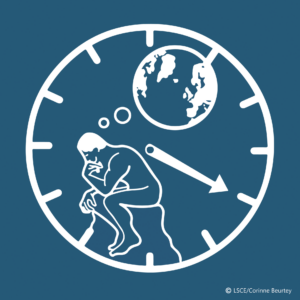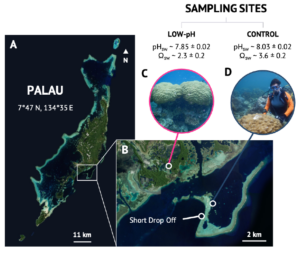L’acidification continue des océans est connue pour être une menace majeure pour les récifs coralliens tropicaux. À ce jour, seules quelques études ont évalué l’impact d’une exposition naturelle à long terme à une eau de mer à faible pH sur la régulation chimique et la croissance des coraux bâtisseurs de récifs. Ce travail a étudié les différentes réponses du corail massif Porites vivant dans des conditions normales (pHsw ~ 8,03) et naturellement à faible pH (pHsw ~ 7,85) de l’eau de mer à Palau (Fig. 1) au cours des dernières décennies.
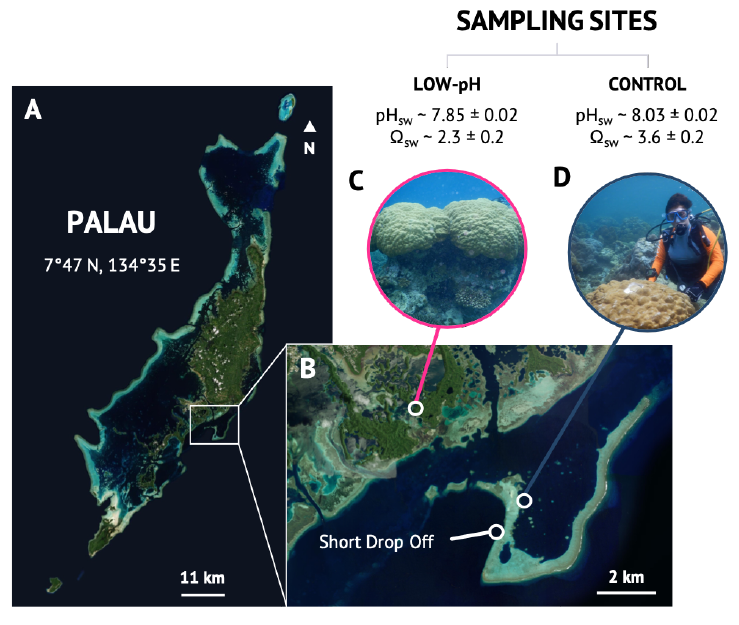
Fig. 1. Sites d’échantillonnage du corail à Palau, Micronésie. (A) Image satellite des principales îles de Palau. (B) Sites d’échantillonnage où les deux colonies de Porites ont été échantillonnées en 2018 sur le site de contrôle (gris) et le site à faible pH (rose). Les deux sites sont caractérisés par différentes propriétés chimiques des carbonates de l’eau de mer. Short Drop Off correspond au site où les températures in situ ont été mesurées (wtc.coralreefpalau.org).
Nos résultats montrent que les deux colonies de Porites ont conservé des propriétés carbonatées similaires (pHcf, [CO32-]cf, DICcf, et Wcf) dans leur fluide de calcification depuis 1972. Cependant, le squelette de Porites dans les conditions les plus acidifiées a révélé une densité significativement plus faible (~ 1,21 ± 0,09 g-cm-3) que le squelette du site en pleine mer (~ 1,41 ± 0,07 g-cm-3) (Fig. 2).
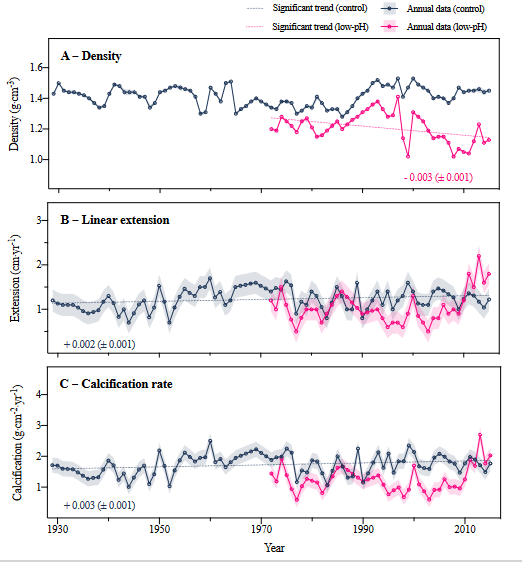
Fig. 2. Paramètres de croissance et de calcification des colonies squelettiques de Porites provenant des sites de contrôle (gris) et des sites à faible pH (rose) à Koror (Palau). Les valeurs en gris ou en rose correspondent à la pente de toute régression linéaire significative ± erreur standard. (A) Taux d’extension (cm-an-1), (B) densité (g-cm-3), et (C) taux de calcification (g-cm-2-an-1). Les lignes grises et roses représentent les variations à l’intérieur de l’erreur estimée (surface remplie) dans les colonies de Porites extraites dans les sites de contrôle et de faible pH respectivement.
Dans l’ensemble, les deux colonies de Porites ont exercé un contrôle biologique fort pour maintenir la stabilité de la chimie du carbonate du fluide calcifiant qui a favorisé le processus de calcification, en particulier dans des conditions de faible pH. Cependant, la diminution de la densité du squelette observée dans des conditions de faible pH donne des indications essentielles sur la vulnérabilité de Porites aux futurs changements planétaires (Fig. 3).
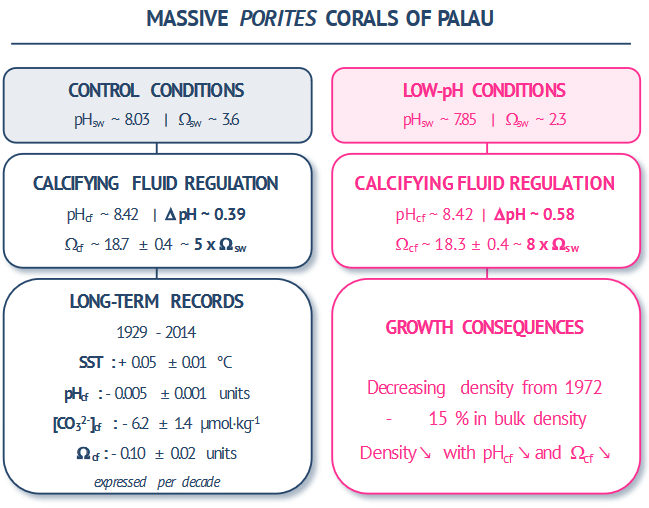
Fig. 3. Résumé schématique des réponses à l’acidification des océans mesurées dans les coraux Porites massifs de Palau au cours de la période 1972-2015, où DpH = pHcf – pHsw.
Référence: Marine Canesi, E. Douville, L. Bordier, A. Dapoigny, G. E. H. Coulibaly, P. Montagna, E. Béraud, D. Allemand, S. Planes, P. Furla, E. Gilson, S. Roberty, D. Zoccola, S. Reynaud, 2024.Porites’ coral calcifying fluid chemistry regulation under normal- and low-pH seawater conditions in Palau Archipelago: Impacts on growth properties. Sci. Total Environ., 2024, 911, DOI : 10.1016/j.scitotenv.2023.168552

